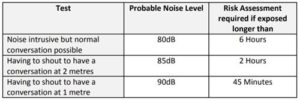According to the 2008/09 Labour Force Survey (LFS), some 17,000 people in the UK suffer deafness, ringing in the ears or other ear conditions caused by excessive noise at work.
The Control of Noise at Work Regulations 2005 are designed to protect against the risks to both workers’ health and safety from exposure to noise and to ensure that workers’ hearing is protected from excessive noise at their place of work, which could cause them to lose their hearing and/or to suffer from tinnitus (permanent ringing in the ears).
By law, as an employer, you must assess and identify measures to eliminate or reduce risks from exposure to noise so that you can protect the hearing of your employees.
Where the risks are low, the actions you take may be simple and inexpensive, but where the risks are high, you should manage them using a prioritised noise-control action plan.
Conducting a noise risk assessment ensures that valid decisions about the risks operatives are exposed to have been considered. It also determines what actions must be taken to ensure the risk is eliminated or adequately controlled. If it is likely a noise hazard exists in the workplace, then the employer will more than likely need to have a noise assessment carried out by a competent person. The noise assessment will involve measuring noise levels with specialist equipment, assessing the exposure and developing an action plan.
In order to carry out a suitable and sufficient risk assessment, it is necessary to know the maximum exposure limit values and action values.

In order to assess the risk from noise there are 5 stages that the employer should consider:
Is there a risk due to noise?
If you answer yes to any of the questions below you have a potential risk from noise and should undertake further investigation:
The persons who may be affected by the noise may include, but are not limited to:
Simple test to see if a noise assessment is required.

If in doubt carry out a risk assessment.
Noise levels that employees are exposed to need to be determined in either daily or weekly personal noise exposure levels. In order to make this estimation it is necessary to make reference to probable levels of noise relating to both equipment and conditions. When employees are working on other employer’s sites, the host employer should have risk assessments in place for any areas or activities where exposure to noise poses a risk. These should be readily available to anyone who may be exposed to the noise while working or visiting that site.
It is not necessary to make a precise assessment of noise exposure. However, you must be able to demonstrate that the data used to make your assessment is both reliable and representative of your employee’s exposure. In the event that the information used is not from measurements within the workplace, it is necessary to demonstrate that the data is representative and you must apply a greater uncertainty factor. In determining the length of time that operatives are exposed to noise, it is best to use direct observation of the work as well as discussions with the operative.
A Noise Exposure Calculator can be found at http://www.hse.gov.uk/noise/calculator.htm
Assessing weekly personal noise levels may not be appropriate unless daily noise exposure on 1 or 2 working days in a week is at least 5dB higher than the other days, or the working week comprises 3 or fewer days of exposure. External assistance from a competent person may be required.
Once the relevant levels of exposure have been assessed it is necessary to check against the exposure action values to determine the level of control required, and to address the immediate risk by issuing suitable hearing protection.
Once the immediate risk has been dealt with, it is necessary to determine what can be done to control the noise, how much it can be reduced and what is reasonably practicable and relevant to your industry. Establish a plan of action to prioritise the methods of noise reduction and a realistic timescale to bring about the changes. Cost will ultimately dictate the implementation timetable for any relevant controls. However, as long as adequate protective measures are in place, then more expensive control measures could be planned into a medium to long-term priority.
When assessing the risks from noise exposure the following hierarchy of control measures must be considered:
The general requirements of hearing protection are as follows:
Employees need to know:
Employees are also responsible for using hearing protection and reporting defects.